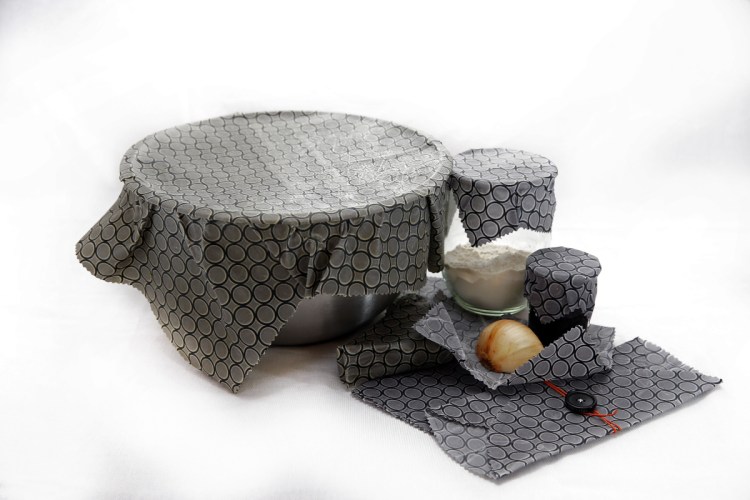Early in my writing career, I had an editor who curbed my enthusiasm for alliteration. While she definitely didn’t disapprove of the dastardly device, she was decidedly disinclined to let me deploy its domination with such distinct and determined dedication as I was doing in my drafts.
I’m guessing the eco-marketeers working to reign in the plastic waste stream in modern America didn’t have the same editor. Added to the catchy reduce-reuse-recycle trilogy espoused by the 1970s movement to make Americans more environmentally conscious, we now have refuse (the plastic packaging in the first place), recover (perfectly usable wares discarded by others), repair (these things to working order) and repurpose (them for handy items their creators could not have fathomed they would be used for).
Such was the case with the cotton shirt my friend Carmen transformed into a variety of beeswax-coated, plastic replacing, washable sheets of food wrap. The warmth of your hand softens the wax in the wraps just enough so that they bend around a bowl of salad, jar of yogurt or half an onion you want to keep fresh. The wraps are reusable because they can be washed in tepid (not hot) water and soap.
I’d bet my kid’s college fund that upscale British designer Robert Graham did not foresee his colorful pinstriped shirt with flowery French cuffs being repurposed for a beeswax baguette bag. But Carmen certainly made it into a lovely one thanks to inspiration from a YouTube video.
She’d learned the DIY process for making commercially available products like Bee’s Wrap and Abeego from a neighbor who started assembling colorful sandwich wraps for her kids’ lunches to make better use of the scraps of cloth she had in her sewing room. Carmen has since tapped her own stash of cotton fabric to make homemade holiday gifts for all of her green-minded friends.
The process is easy. Heat an oven to 185 degrees. Line a baking sheet with a piece of parchment and place a clean, wooden-handled paintbrush on the sheet. Warm the tray in the oven for about five minutes. Pull the tray out of the oven, spread a piece of cloth that’s been trimmed on all edges with pinking shears (an 11-by-17-inch rectangle will hold a bunch of celery, a 9-inch circle is perfect to wrap a sandwich and a 4-inch quilting square is great for an onion half) on the parchment paper. Sprinkle about one tablespoon of cosmetic/food grade beeswax pellets (Carmen gets hers on Amazon) or shavings from a block of beeswax (I got mine at The Honey Exchange in Portland) per every 4 square inches of cloth. Slide the pan into the oven and bake until the wax is melted, three to five minutes. Remove the pan from the oven. Use the paintbrush to spread the wax evenly over the cloth and immediately hang the treated sheet to cool on a clothespin attached to a hanger. The sheets are ready to use within two minutes.

Christine Burns Rudalevige grates beeswax to make a sustainable alternative to plastic food wrap.
The commercially available wraps – typically squares of muslin treated with beeswax, jojoba and pine resin – have been touted as a sustainable replacement for rolls and rolls of plastic cling film in the home kitchen. Jojoba, which looks like an oil but is actually a liquid wax ester extracted from these plants that grow in the deserts of the Southwest, makes the wraps a bit softer than if treated with straight beeswax. The resin makes them just a bit stickier for a tighter seal about the food.
Ironically enough, there is a jojoba processor in Waldoboro called the Jojoba Company, and my internet order arrived at my door within 48 hours. Adding a few drops around the sheet before spreading the hot wax, both Carmen and I found, does make the end product softer, more malleable. We also found the wraps to be sticky enough, so we bypassed the hassle of sourcing food-grade resin and incorporating it into what is otherwise a hassle-free craft that helps reduce our overall use of plastic in the kitchen.
ABOUT THE WRITER
CHRISTINE BURNS RUDALEVIGE is a food writer, recipe developer and tester and cooking teacher in Brunswick, and the author of “Green Plate Special,” a cookbook from Islandport based on these columns. She can be contacted at cburns1227@gmail.com.
Send questions/comments to the editors.



Success. Please wait for the page to reload. If the page does not reload within 5 seconds, please refresh the page.
Enter your email and password to access comments.
Hi, to comment on stories you must . This profile is in addition to your subscription and website login.
Already have a commenting profile? .
Invalid username/password.
Please check your email to confirm and complete your registration.
Only subscribers are eligible to post comments. Please subscribe or login first for digital access. Here’s why.
Use the form below to reset your password. When you've submitted your account email, we will send an email with a reset code.